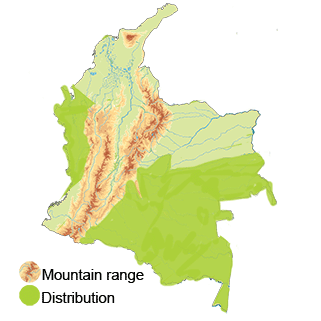Crested Eagle
The Crested Eagle (Morphnus guianensis) is another impressive bird of prey found in the forests of Colombia. Read in Spanish
Appearance: The Crested Eagle is a large raptor with a distinctive appearance characterized by a prominent crest of feathers on its head, giving it its name. It has a dark brown plumage with a barred tail and boldly patterned underwing feathers, which are visible in flight. The Crested Eagle also has a hooked beak, powerful talons, and a yellow, strongly hooked bill for grasping and dispatching prey.
Habitat: The Crested Eagle inhabits primarily the tropical rainforests of Central and South America, including countries like Colombia, Venezuela, Brazil, and Peru. In Colombia, the Crested Eagle can be found in the Amazon basin, the Andean foothills, and other forested regions with suitable prey availability.
Behavior: Crested Eagles are apex predators in their habitats, preying on a variety of animals, including small to medium-sized mammals, birds, and reptiles. They are skilled hunters and often hunt from perches or engage in brief, powerful flights to capture prey. Like other large raptors, Crested Eagles are known for their stealth and agility in pursuit of prey. These eagles are generally solitary birds, although they may form monogamous pairs during the breeding season.
Breeding: Crested Eagles typically nest in tall trees, constructing large stick nests in the forest canopy to raise their young. The female usually lays one to two eggs, with an incubation period of around 40 to 45 days. Both parents share the responsibilities of incubating the eggs and caring for the chicks. Young Crested Eagles remain in the care of their parents for an extended period, learning essential hunting and survival skills before they eventually become independent.
Conservation Status:The Crested Eagle is classified as "Near Threatened" on the IUCN Red List of Threatened Species.
Distribution
The Crested Eagle (Morphnus guianensis) The Crested Eagle can be found:
Amazon Region: The Crested Eagle is commonly found in the Amazon region of Colombia, which includes departments such as Amazonas, Caquetá, Guainía, Guaviare, Putumayo, Vaupés, and parts of Meta and Vichada. The dense rainforests and diverse ecosystems of the Amazon provide suitable habitat for this species.
Orinoco Region: Parts of the eastern Orinoco region in Colombia are also within the distribution range of the Crested Eagle. This includes departments such as Meta, Vichada, Arauca, and Casanare, where the species can be found in the extensive savannas and gallery forests adjacent to the Orinoco River.
Andean Foothills: The species may also occur in the foothills of the Andes Mountains in Colombia, particularly in regions where the Andes meet the Amazon and Orinoco basins. This includes areas in departments such as Meta, Guaviare, and Caquetá.
Northern Colombia: While less common, the Crested Eagle may also be found in northern regions of Colombia, including areas in departments such as Cesar, Norte de Santander, and Santander, where suitable forested habitats are present.
Taxonomy
The Crested Eagle (Morphnus guianensis)
- Kingdom: Animalia
- Phylum: Chordata
- Class: Aves (Birds)
- Order: Accipitriformes
- Family: Accipitridae
- Genus: Morphnus
- Species: Morphnus guianensis
Vocalization
The Crested Eagle (Morphnus guianensis)
- Hooting Calls: The Crested Eagle may produce deep, resonant hoots or hoo-hoo calls. These hooting calls could be used for territorial displays, mating calls, or to communicate with other eagles in the area.
- Screeching Calls: Like many raptors, the Crested Eagle may emit piercing screeches or screams, especially during territorial disputes, to express alarm, or to signal aggression towards intruders.
- Chattering Calls: Crested Eagles may engage in chattering or rattling vocalizations, consisting of rapid, staccato-like sounds. These chattering calls could be used during interactions between mating pairs, parents and offspring, or as part of courtship displays.
- Whistling Calls: Some raptors, including the Crested Eagle, may also produce melodious whistles or piping calls. These whistling calls could serve various purposes such as attracting mates, maintaining contact with other eagles, or signaling their presence in the area.
- Contact Calls: Crested Eagles may use softer contact calls, such as chirps or mewing sounds, to communicate with other individuals in their territory or to locate their mate during hunting or foraging activities.
- Alarm Calls: When threatened or disturbed, the Crested Eagle may emit warning calls or alarm vocalizations to alert others of potential danger or to deter predators from approaching their nest sites.





